Consumer Behavior Analysis: Income, Age, Culture (NCIRL)
VerifiedAdded on 2019/09/26
|43
|10904
|79
Report
AI Summary
This report provides an overview of consumer behavior, emphasizing the impact of income, age, and cultural factors on purchasing decisions. It explores how income levels, including discretionary income, influence spending patterns and how consumer confidence affects spending versus saving. The report examines the roles of social class, family, and reference groups in shaping consumer choices, alongside the influence of cultural norms and values. It also discusses how marketers target consumers based on income and age, considering factors like employment rates and economic trends. The analysis includes a focus on how cultural norms and values influence consumer behavior and decision-making processes. This report aims to provide a comprehensive understanding of the complex factors that drive consumer choices.
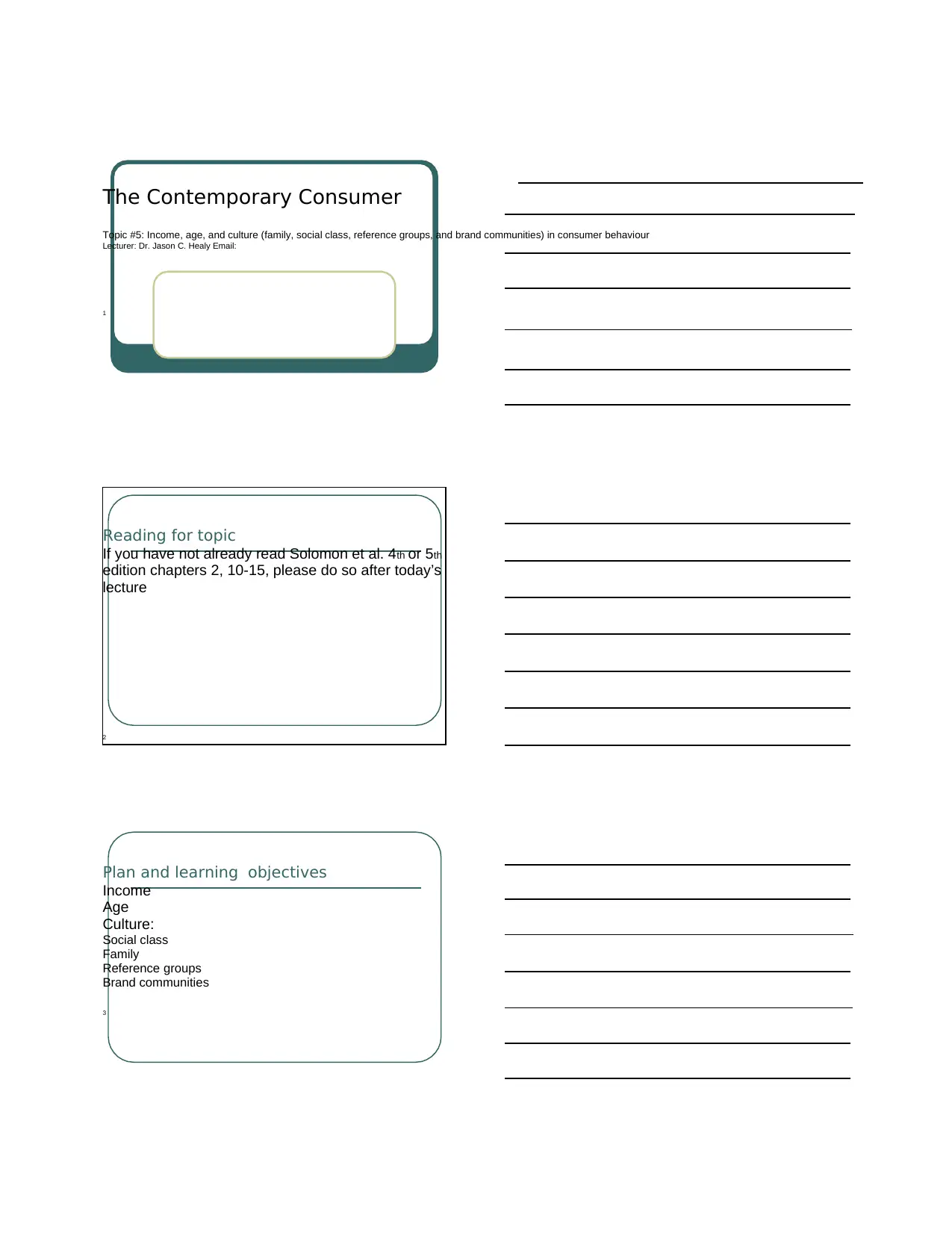
Reading for topic
If you have not already read Solomon et al. 4th or 5th
edition chapters 2, 10-15, please do so after today’s
lecture
2
The Contemporary Consumer
Topic #5: Income, age, and culture (family, social class, reference groups, and brand communities) in consumer behaviour
Lecturer: Dr. Jason C. Healy Email:
1
Plan and learning objectives
Income
Age
Culture:
Social class
Family
Reference groups
Brand communities
3
If you have not already read Solomon et al. 4th or 5th
edition chapters 2, 10-15, please do so after today’s
lecture
2
The Contemporary Consumer
Topic #5: Income, age, and culture (family, social class, reference groups, and brand communities) in consumer behaviour
Lecturer: Dr. Jason C. Healy Email:
1
Plan and learning objectives
Income
Age
Culture:
Social class
Family
Reference groups
Brand communities
3
Paraphrase This Document
Need a fresh take? Get an instant paraphrase of this document with our AI Paraphraser
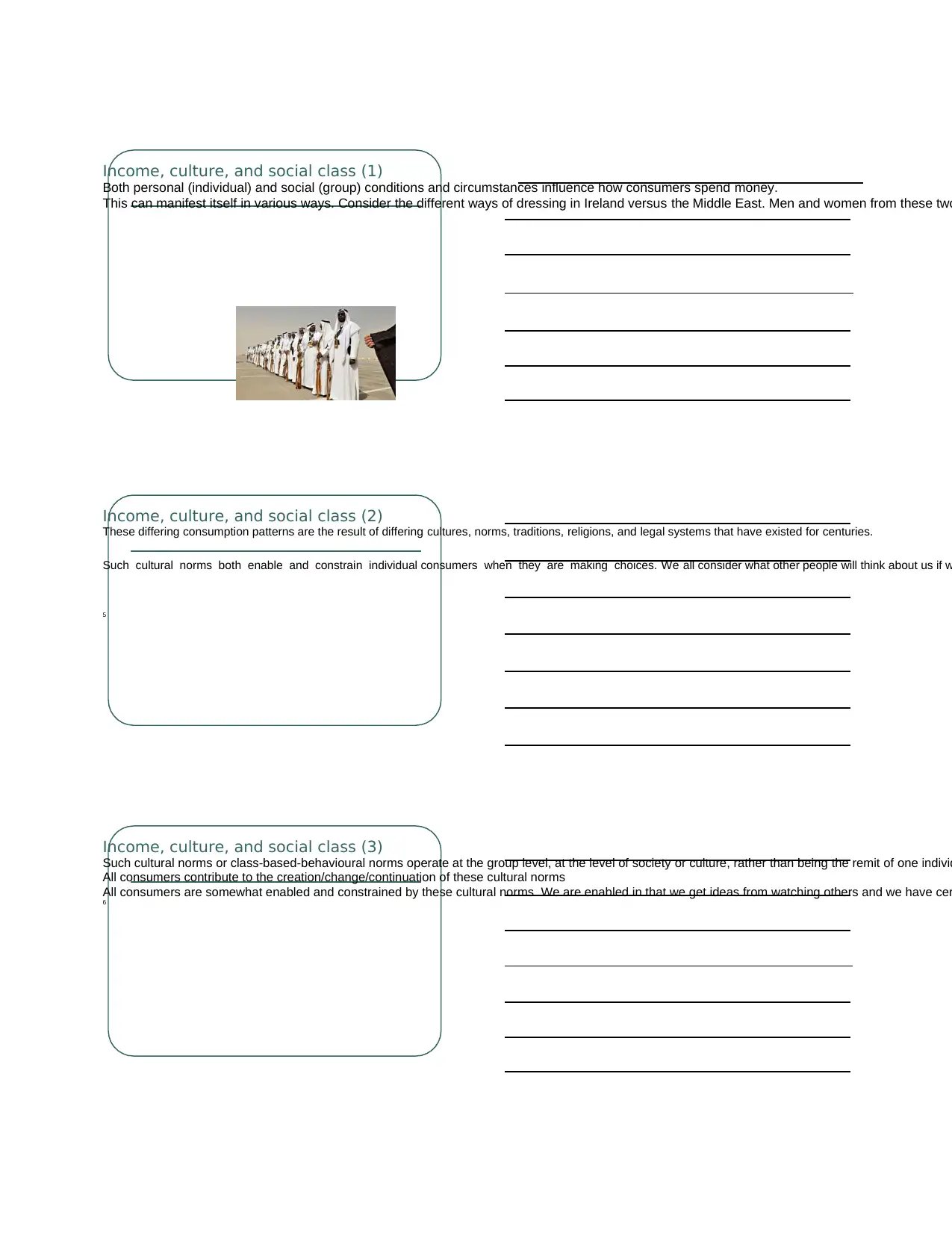
4
Income, culture, and social class (2)
These differing consumption patterns are the result of differing cultures, norms, traditions, religions, and legal systems that have existed for centuries.
Such cultural norms both enable and constrain individual consumers when they are making choices. We all consider what other people will think about us if w
5
Income, culture, and social class (1)
Both personal (individual) and social (group) conditions and circumstances influence how consumers spend money.
This can manifest itself in various ways. Consider the different ways of dressing in Ireland versus the Middle East. Men and women from these two
Income, culture, and social class (3)
Such cultural norms or class-based-behavioural norms operate at the group level, at the level of society or culture, rather than being the remit of one individ
All consumers contribute to the creation/change/continuation of these cultural norms
All consumers are somewhat enabled and constrained by these cultural norms. We are enabled in that we get ideas from watching others and we have cer
6
Income, culture, and social class (2)
These differing consumption patterns are the result of differing cultures, norms, traditions, religions, and legal systems that have existed for centuries.
Such cultural norms both enable and constrain individual consumers when they are making choices. We all consider what other people will think about us if w
5
Income, culture, and social class (1)
Both personal (individual) and social (group) conditions and circumstances influence how consumers spend money.
This can manifest itself in various ways. Consider the different ways of dressing in Ireland versus the Middle East. Men and women from these two
Income, culture, and social class (3)
Such cultural norms or class-based-behavioural norms operate at the group level, at the level of society or culture, rather than being the remit of one individ
All consumers contribute to the creation/change/continuation of these cultural norms
All consumers are somewhat enabled and constrained by these cultural norms. We are enabled in that we get ideas from watching others and we have cer
6

7
Income, culture, and social class (4)
An example of how these cultural norms can change. Even if we consider norms of clothing for Irish people now, versus 100 years ago, we can se
Income, culture, and social class (5)
This latter example of the flat cap was very much related to social class, traditionally. The wearing of a flat cap in the UK and Ireland tended to signify that the wearer was not a member of the
During the 20th century, other types of hat also became linked to certain classes within society. E.g. the bowler hat was heavily linked to signifying that the wearer was an urban professional pe
8
Income, culture, and social class (6)
As evidenced by the hat discussion, consumers are grouped in social classes that say a lot about where they stand in society and also influence our consumer behav
Actual or desired class influences buyer behaviour. A person’s desire to make a statement about their social class, or the class to which they hope to belong, influenc
Products are frequently bought and displayed as markers of social class; they are valued as status symbols. E.g. do we express our social class in the clothes we we
9
Income, culture, and social class (4)
An example of how these cultural norms can change. Even if we consider norms of clothing for Irish people now, versus 100 years ago, we can se
Income, culture, and social class (5)
This latter example of the flat cap was very much related to social class, traditionally. The wearing of a flat cap in the UK and Ireland tended to signify that the wearer was not a member of the
During the 20th century, other types of hat also became linked to certain classes within society. E.g. the bowler hat was heavily linked to signifying that the wearer was an urban professional pe
8
Income, culture, and social class (6)
As evidenced by the hat discussion, consumers are grouped in social classes that say a lot about where they stand in society and also influence our consumer behav
Actual or desired class influences buyer behaviour. A person’s desire to make a statement about their social class, or the class to which they hope to belong, influenc
Products are frequently bought and displayed as markers of social class; they are valued as status symbols. E.g. do we express our social class in the clothes we we
9
⊘ This is a preview!⊘
Do you want full access?
Subscribe today to unlock all pages.

Trusted by 1+ million students worldwide
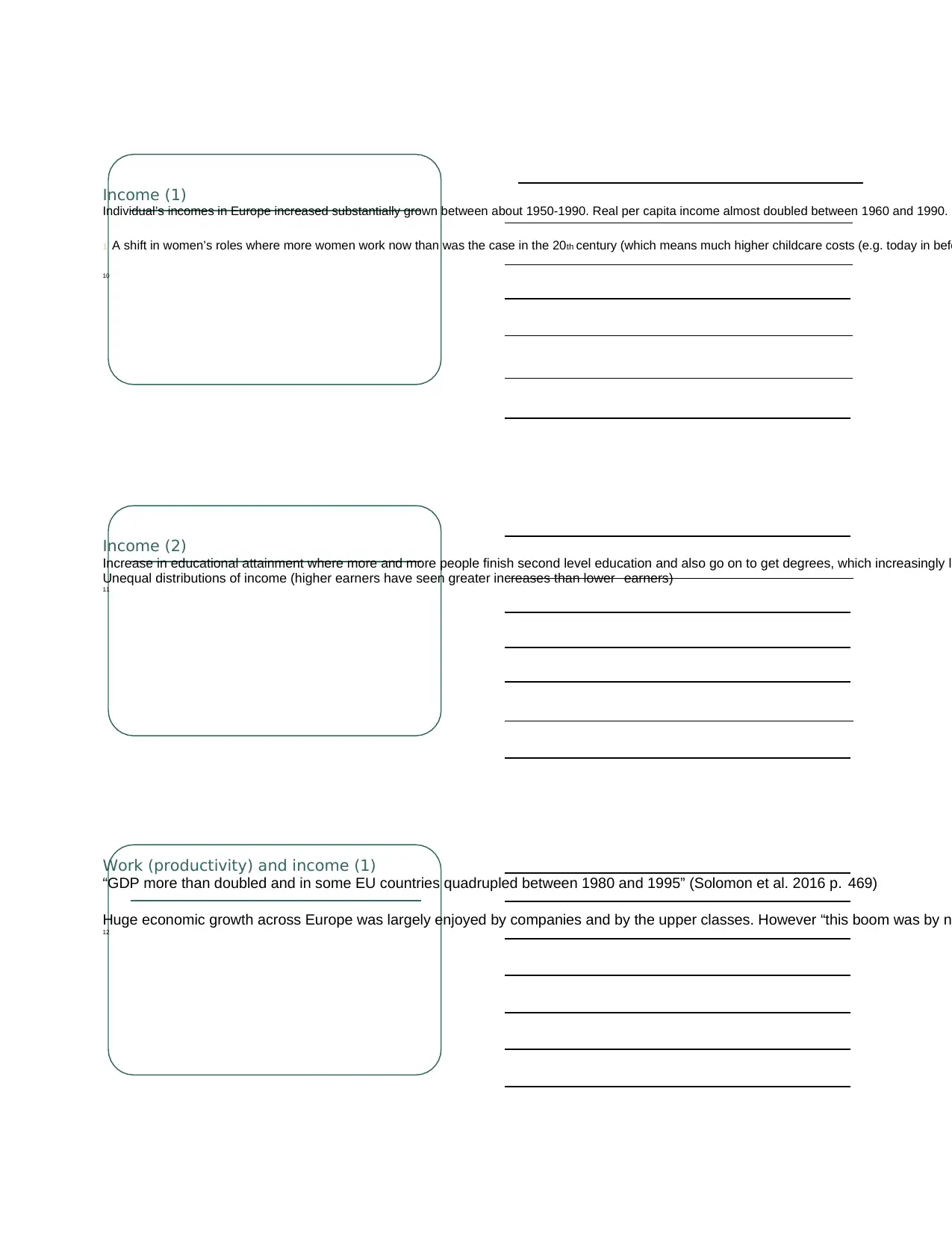
Income (1)
Individual’s incomes in Europe increased substantially grown between about 1950-1990. Real per capita income almost doubled between 1960 and 1990. H
1. A shift in women’s roles where more women work now than was the case in the 20th century (which means much higher childcare costs (e.g. today in befo
10
Income (2)
Increase in educational attainment where more and more people finish second level education and also go on to get degrees, which increasingly le
Unequal distributions of income (higher earners have seen greater increases than lower earners)
11
Work (productivity) and income (1)
“GDP more than doubled and in some EU countries quadrupled between 1980 and 1995” (Solomon et al. 2016 p. 469)
Huge economic growth across Europe was largely enjoyed by companies and by the upper classes. However “this boom was by no
12
Individual’s incomes in Europe increased substantially grown between about 1950-1990. Real per capita income almost doubled between 1960 and 1990. H
1. A shift in women’s roles where more women work now than was the case in the 20th century (which means much higher childcare costs (e.g. today in befo
10
Income (2)
Increase in educational attainment where more and more people finish second level education and also go on to get degrees, which increasingly le
Unequal distributions of income (higher earners have seen greater increases than lower earners)
11
Work (productivity) and income (1)
“GDP more than doubled and in some EU countries quadrupled between 1980 and 1995” (Solomon et al. 2016 p. 469)
Huge economic growth across Europe was largely enjoyed by companies and by the upper classes. However “this boom was by no
12
Paraphrase This Document
Need a fresh take? Get an instant paraphrase of this document with our AI Paraphraser
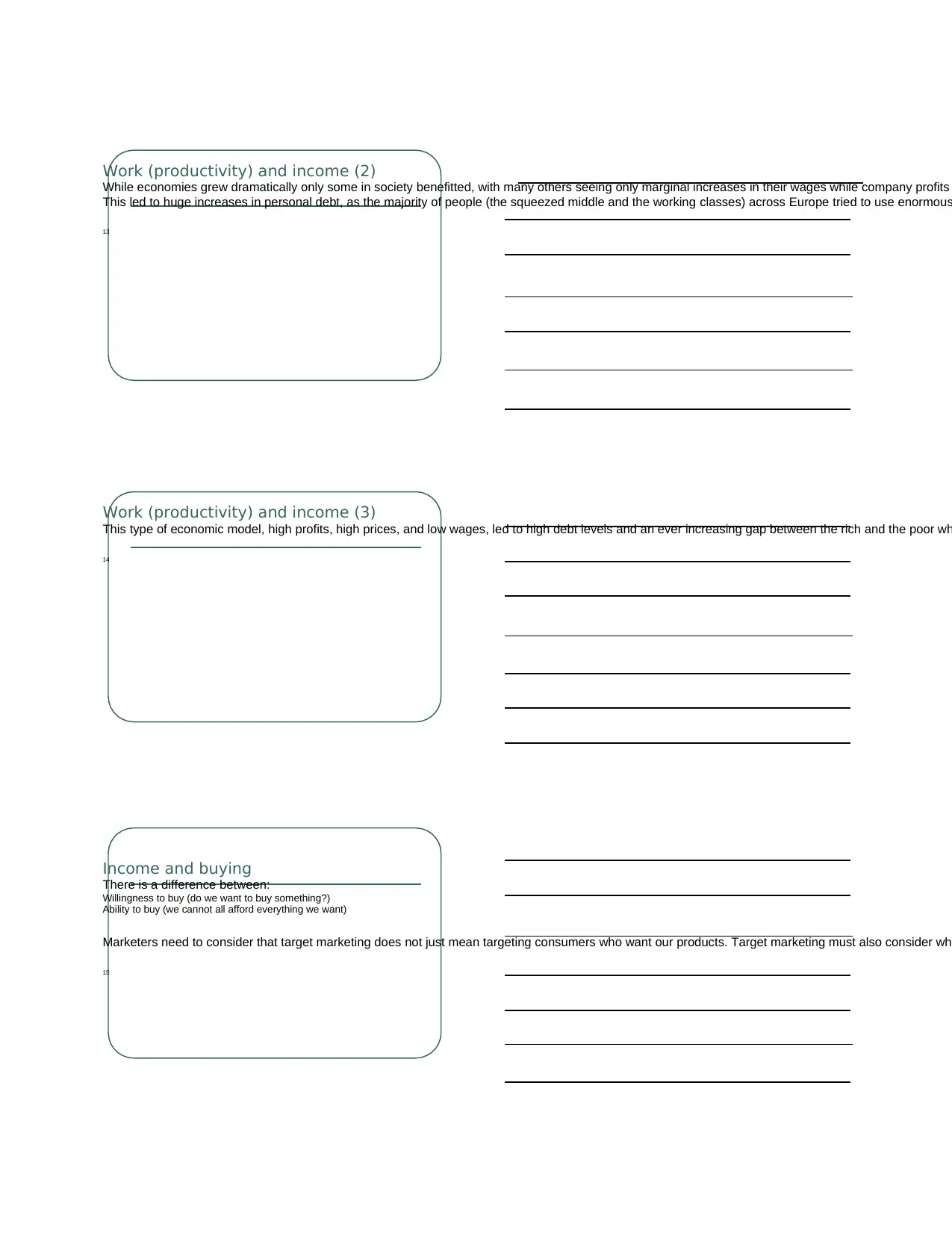
Work (productivity) and income (2)
While economies grew dramatically only some in society benefitted, with many others seeing only marginal increases in their wages while company profits
This led to huge increases in personal debt, as the majority of people (the squeezed middle and the working classes) across Europe tried to use enormous
13
Work (productivity) and income (3)
This type of economic model, high profits, high prices, and low wages, led to high debt levels and an ever increasing gap between the rich and the poor wh
14
Income and buying
There is a difference between:
Willingness to buy (do we want to buy something?)
Ability to buy (we cannot all afford everything we want)
Marketers need to consider that target marketing does not just mean targeting consumers who want our products. Target marketing must also consider who
15
While economies grew dramatically only some in society benefitted, with many others seeing only marginal increases in their wages while company profits
This led to huge increases in personal debt, as the majority of people (the squeezed middle and the working classes) across Europe tried to use enormous
13
Work (productivity) and income (3)
This type of economic model, high profits, high prices, and low wages, led to high debt levels and an ever increasing gap between the rich and the poor wh
14
Income and buying
There is a difference between:
Willingness to buy (do we want to buy something?)
Ability to buy (we cannot all afford everything we want)
Marketers need to consider that target marketing does not just mean targeting consumers who want our products. Target marketing must also consider who
15
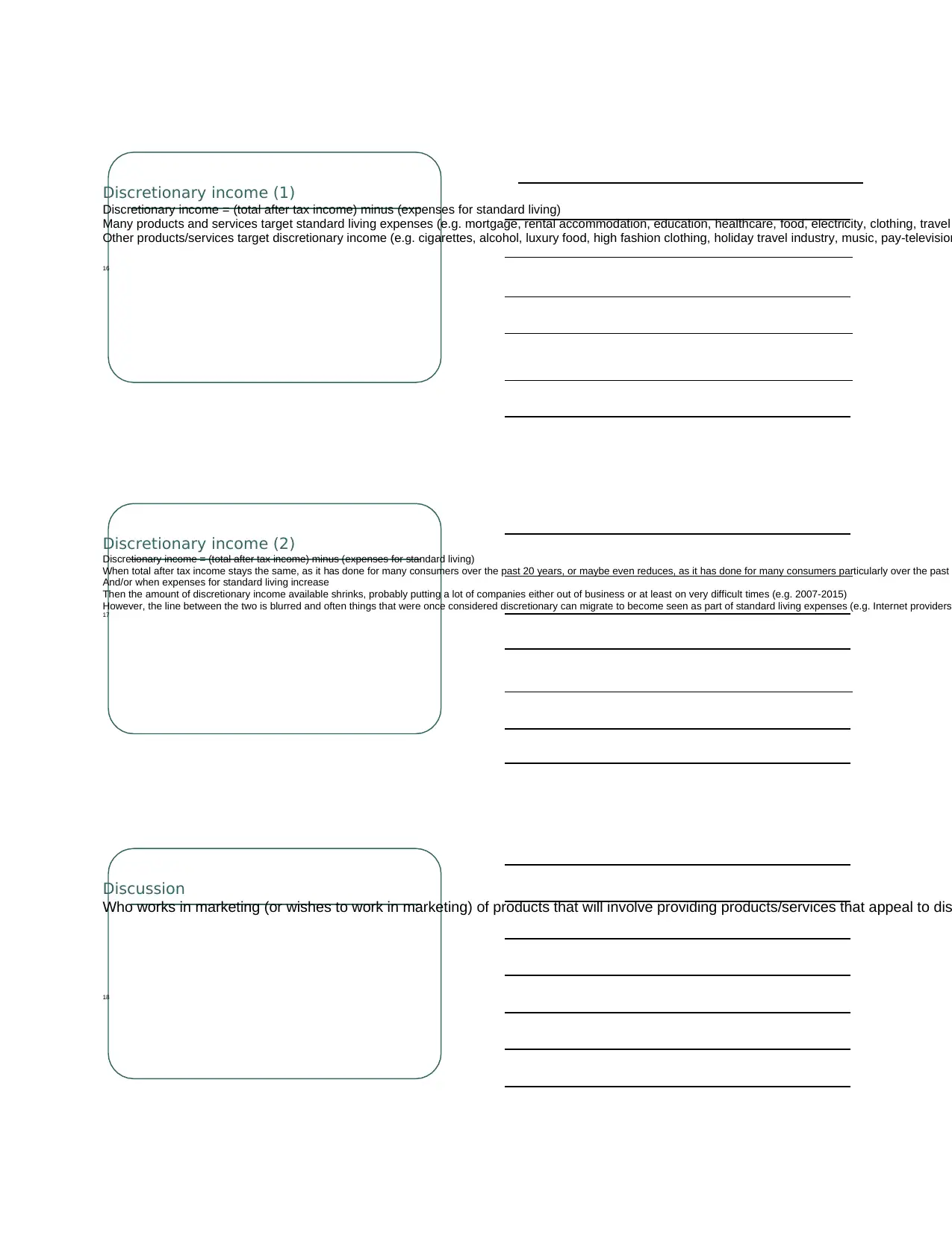
Discretionary income (1)
Discretionary income = (total after tax income) minus (expenses for standard living)
Many products and services target standard living expenses (e.g. mortgage, rental accommodation, education, healthcare, food, electricity, clothing, travel
Other products/services target discretionary income (e.g. cigarettes, alcohol, luxury food, high fashion clothing, holiday travel industry, music, pay-television
16
Discretionary income (2)
Discretionary income = (total after tax income) minus (expenses for standard living)
When total after tax income stays the same, as it has done for many consumers over the past 20 years, or maybe even reduces, as it has done for many consumers particularly over the past d
And/or when expenses for standard living increase
Then the amount of discretionary income available shrinks, probably putting a lot of companies either out of business or at least on very difficult times (e.g. 2007-2015)
However, the line between the two is blurred and often things that were once considered discretionary can migrate to become seen as part of standard living expenses (e.g. Internet providers
17
Discussion
Who works in marketing (or wishes to work in marketing) of products that will involve providing products/services that appeal to dis
18
Discretionary income = (total after tax income) minus (expenses for standard living)
Many products and services target standard living expenses (e.g. mortgage, rental accommodation, education, healthcare, food, electricity, clothing, travel
Other products/services target discretionary income (e.g. cigarettes, alcohol, luxury food, high fashion clothing, holiday travel industry, music, pay-television
16
Discretionary income (2)
Discretionary income = (total after tax income) minus (expenses for standard living)
When total after tax income stays the same, as it has done for many consumers over the past 20 years, or maybe even reduces, as it has done for many consumers particularly over the past d
And/or when expenses for standard living increase
Then the amount of discretionary income available shrinks, probably putting a lot of companies either out of business or at least on very difficult times (e.g. 2007-2015)
However, the line between the two is blurred and often things that were once considered discretionary can migrate to become seen as part of standard living expenses (e.g. Internet providers
17
Discussion
Who works in marketing (or wishes to work in marketing) of products that will involve providing products/services that appeal to dis
18
⊘ This is a preview!⊘
Do you want full access?
Subscribe today to unlock all pages.

Trusted by 1+ million students worldwide
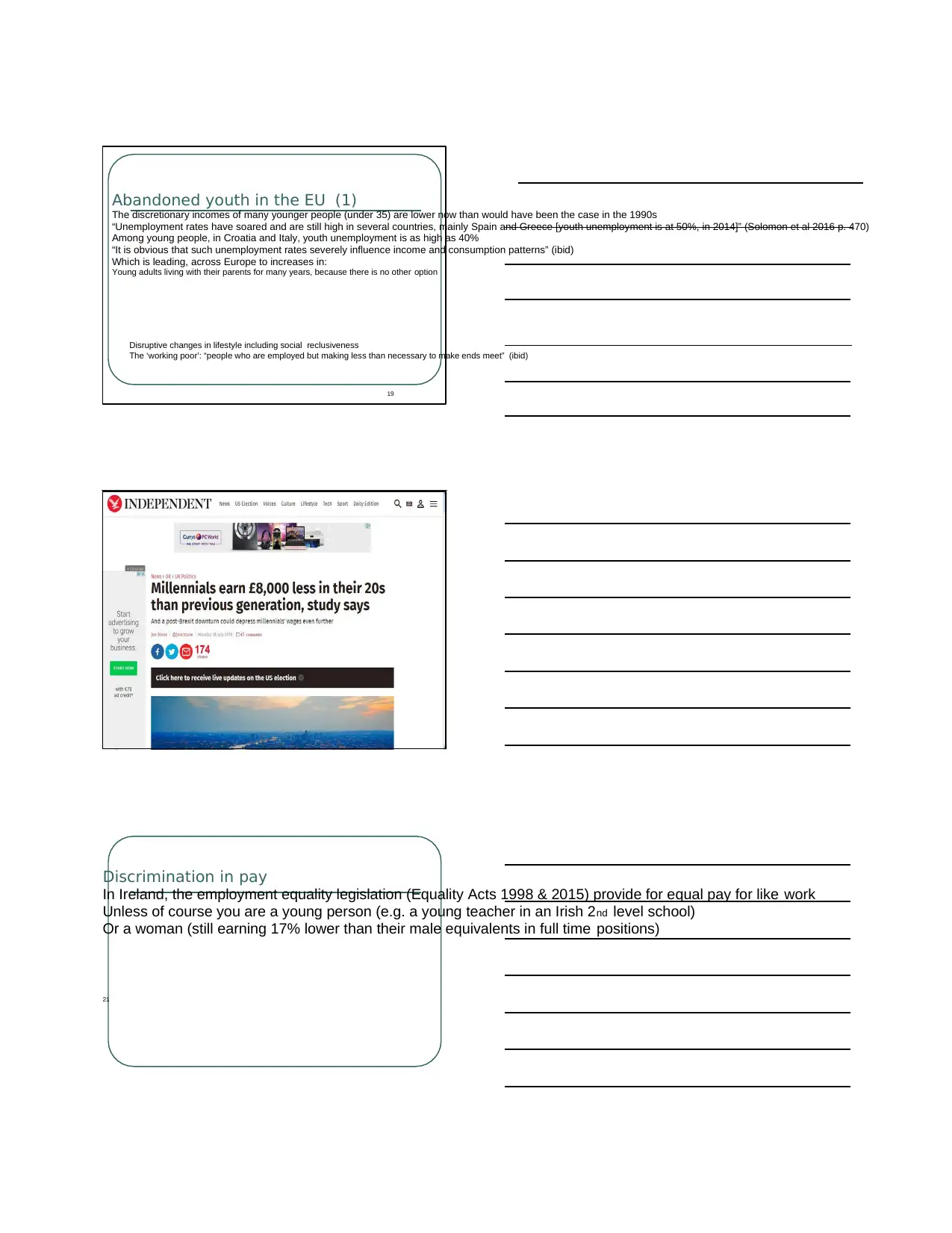
20
Discrimination in pay
In Ireland, the employment equality legislation (Equality Acts 1998 & 2015) provide for equal pay for like work
Unless of course you are a young person (e.g. a young teacher in an Irish 2nd level school)
Or a woman (still earning 17% lower than their male equivalents in full time positions)
21
Abandoned youth in the EU (1)
The discretionary incomes of many younger people (under 35) are lower now than would have been the case in the 1990s
“Unemployment rates have soared and are still high in several countries, mainly Spain and Greece [youth unemployment is at 50%, in 2014]” (Solomon et al 2016 p. 470)
Among young people, in Croatia and Italy, youth unemployment is as high as 40%
“It is obvious that such unemployment rates severely influence income and consumption patterns” (ibid)
Which is leading, across Europe to increases in:
Young adults living with their parents for many years, because there is no other option
Disruptive changes in lifestyle including social reclusiveness
The ‘working poor’: “people who are employed but making less than necessary to make ends meet” (ibid)
19
Discrimination in pay
In Ireland, the employment equality legislation (Equality Acts 1998 & 2015) provide for equal pay for like work
Unless of course you are a young person (e.g. a young teacher in an Irish 2nd level school)
Or a woman (still earning 17% lower than their male equivalents in full time positions)
21
Abandoned youth in the EU (1)
The discretionary incomes of many younger people (under 35) are lower now than would have been the case in the 1990s
“Unemployment rates have soared and are still high in several countries, mainly Spain and Greece [youth unemployment is at 50%, in 2014]” (Solomon et al 2016 p. 470)
Among young people, in Croatia and Italy, youth unemployment is as high as 40%
“It is obvious that such unemployment rates severely influence income and consumption patterns” (ibid)
Which is leading, across Europe to increases in:
Young adults living with their parents for many years, because there is no other option
Disruptive changes in lifestyle including social reclusiveness
The ‘working poor’: “people who are employed but making less than necessary to make ends meet” (ibid)
19
Paraphrase This Document
Need a fresh take? Get an instant paraphrase of this document with our AI Paraphraser
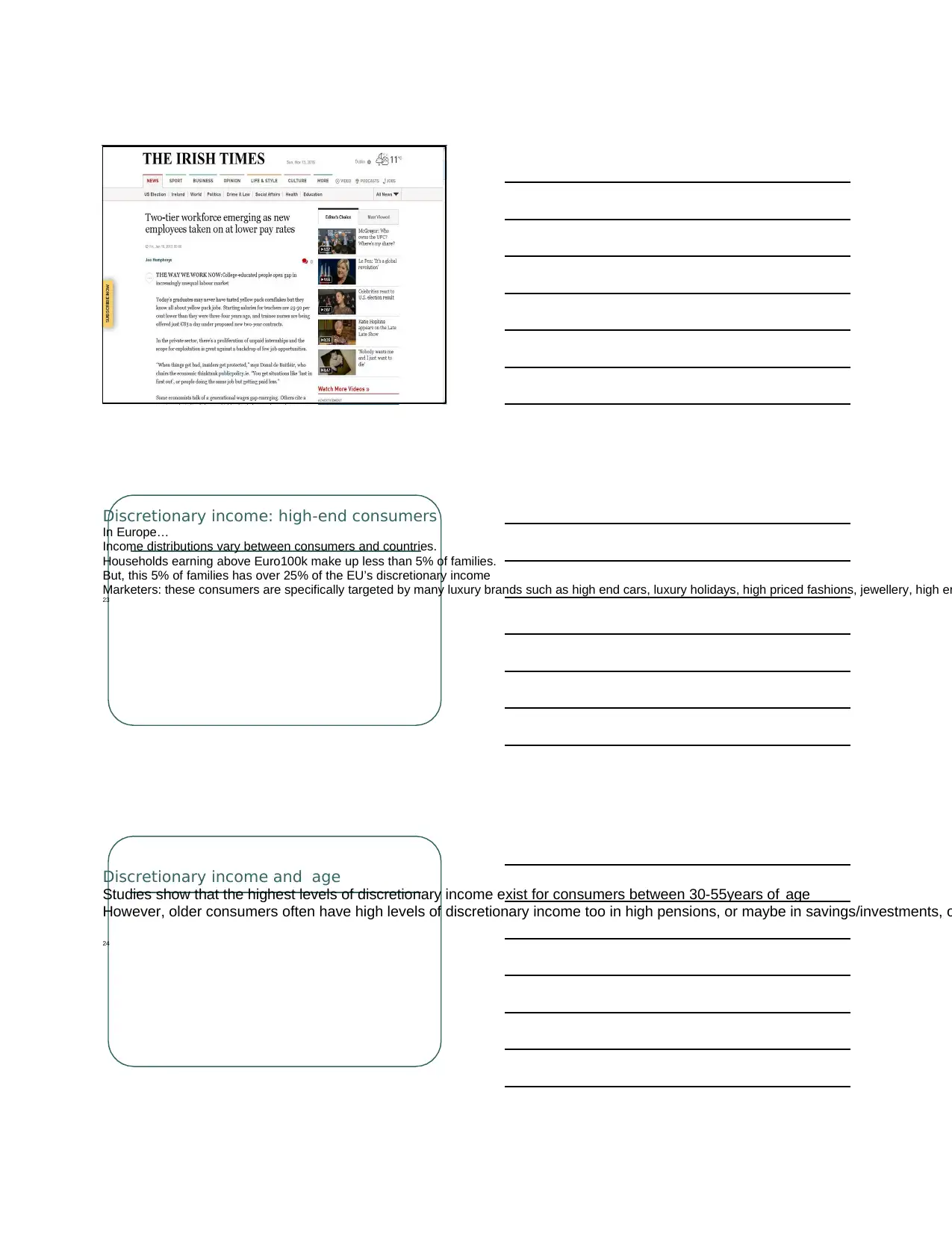
22
Discretionary income: high-end consumers
In Europe…
Income distributions vary between consumers and countries.
Households earning above Euro100k make up less than 5% of families.
But, this 5% of families has over 25% of the EU’s discretionary income
Marketers: these consumers are specifically targeted by many luxury brands such as high end cars, luxury holidays, high priced fashions, jewellery, high en
23
Discretionary income and age
Studies show that the highest levels of discretionary income exist for consumers between 30-55years of age
However, older consumers often have high levels of discretionary income too in high pensions, or maybe in savings/investments, o
24
Discretionary income: high-end consumers
In Europe…
Income distributions vary between consumers and countries.
Households earning above Euro100k make up less than 5% of families.
But, this 5% of families has over 25% of the EU’s discretionary income
Marketers: these consumers are specifically targeted by many luxury brands such as high end cars, luxury holidays, high priced fashions, jewellery, high en
23
Discretionary income and age
Studies show that the highest levels of discretionary income exist for consumers between 30-55years of age
However, older consumers often have high levels of discretionary income too in high pensions, or maybe in savings/investments, o
24
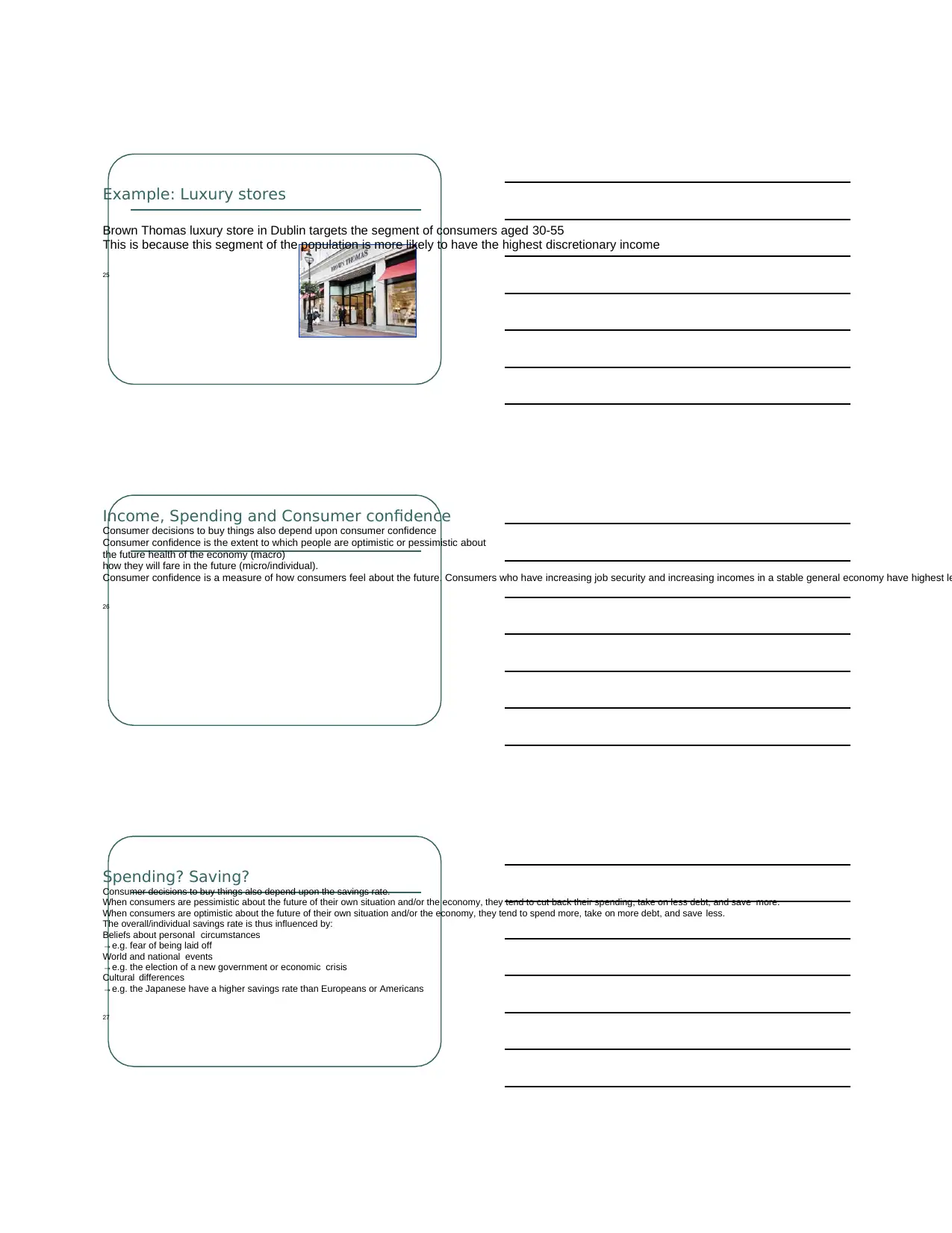
Example: Luxury stores
Brown Thomas luxury store in Dublin targets the segment of consumers aged 30-55
This is because this segment of the population is more likely to have the highest discretionary income
25
Income, Spending and Consumer confidence
Consumer decisions to buy things also depend upon consumer confidence
Consumer confidence is the extent to which people are optimistic or pessimistic about
the future health of the economy (macro)
how they will fare in the future (micro/individual).
Consumer confidence is a measure of how consumers feel about the future. Consumers who have increasing job security and increasing incomes in a stable general economy have highest le
26
Spending? Saving?
Consumer decisions to buy things also depend upon the savings rate.
When consumers are pessimistic about the future of their own situation and/or the economy, they tend to cut back their spending, take on less debt, and save more.
When consumers are optimistic about the future of their own situation and/or the economy, they tend to spend more, take on more debt, and save less.
The overall/individual savings rate is thus influenced by:
Beliefs about personal circumstances
→e.g. fear of being laid off
World and national events
→e.g. the election of a new government or economic crisis
Cultural differences
→e.g. the Japanese have a higher savings rate than Europeans or Americans
27
Brown Thomas luxury store in Dublin targets the segment of consumers aged 30-55
This is because this segment of the population is more likely to have the highest discretionary income
25
Income, Spending and Consumer confidence
Consumer decisions to buy things also depend upon consumer confidence
Consumer confidence is the extent to which people are optimistic or pessimistic about
the future health of the economy (macro)
how they will fare in the future (micro/individual).
Consumer confidence is a measure of how consumers feel about the future. Consumers who have increasing job security and increasing incomes in a stable general economy have highest le
26
Spending? Saving?
Consumer decisions to buy things also depend upon the savings rate.
When consumers are pessimistic about the future of their own situation and/or the economy, they tend to cut back their spending, take on less debt, and save more.
When consumers are optimistic about the future of their own situation and/or the economy, they tend to spend more, take on more debt, and save less.
The overall/individual savings rate is thus influenced by:
Beliefs about personal circumstances
→e.g. fear of being laid off
World and national events
→e.g. the election of a new government or economic crisis
Cultural differences
→e.g. the Japanese have a higher savings rate than Europeans or Americans
27
⊘ This is a preview!⊘
Do you want full access?
Subscribe today to unlock all pages.

Trusted by 1+ million students worldwide

Social class (1)
All societies may be roughly divided into the haves and have-nots
Social equality does not exist and societies have classes
Social class does not just refer to income, but income is important
Social class is determined by a complex set of variables, including income, family background and occupation
The place one occupies in the social structure is an important determinant not only of how much money is spent, but it also influences how it is spent.
28
Social class (2)
Theory of the pecking order: in many animal species, the most aggressive/assertive animals have first pick of food, living quarters, and mating partners. Humans are
People’s standing in social class terms determines their access to:
Education
Housing
Consumer goods
Social mobility: Some individuals try to improve their social standing, or status
This desire to improve one’s social status, and let others know when you do it, is at the core of many marketing strategies (e.g. buying a Ferrari to display how wealthy you are).
29
Social class (3)
Birds of a feather flock together: Social class affects tastes and lifestyles. People in each social class/group tend to socialize with one other, share many
Consumers will usually mimic those with whom they identify as part of their same social class – the products/services/brands they consume and how they c
30
All societies may be roughly divided into the haves and have-nots
Social equality does not exist and societies have classes
Social class does not just refer to income, but income is important
Social class is determined by a complex set of variables, including income, family background and occupation
The place one occupies in the social structure is an important determinant not only of how much money is spent, but it also influences how it is spent.
28
Social class (2)
Theory of the pecking order: in many animal species, the most aggressive/assertive animals have first pick of food, living quarters, and mating partners. Humans are
People’s standing in social class terms determines their access to:
Education
Housing
Consumer goods
Social mobility: Some individuals try to improve their social standing, or status
This desire to improve one’s social status, and let others know when you do it, is at the core of many marketing strategies (e.g. buying a Ferrari to display how wealthy you are).
29
Social class (3)
Birds of a feather flock together: Social class affects tastes and lifestyles. People in each social class/group tend to socialize with one other, share many
Consumers will usually mimic those with whom they identify as part of their same social class – the products/services/brands they consume and how they c
30
Paraphrase This Document
Need a fresh take? Get an instant paraphrase of this document with our AI Paraphraser
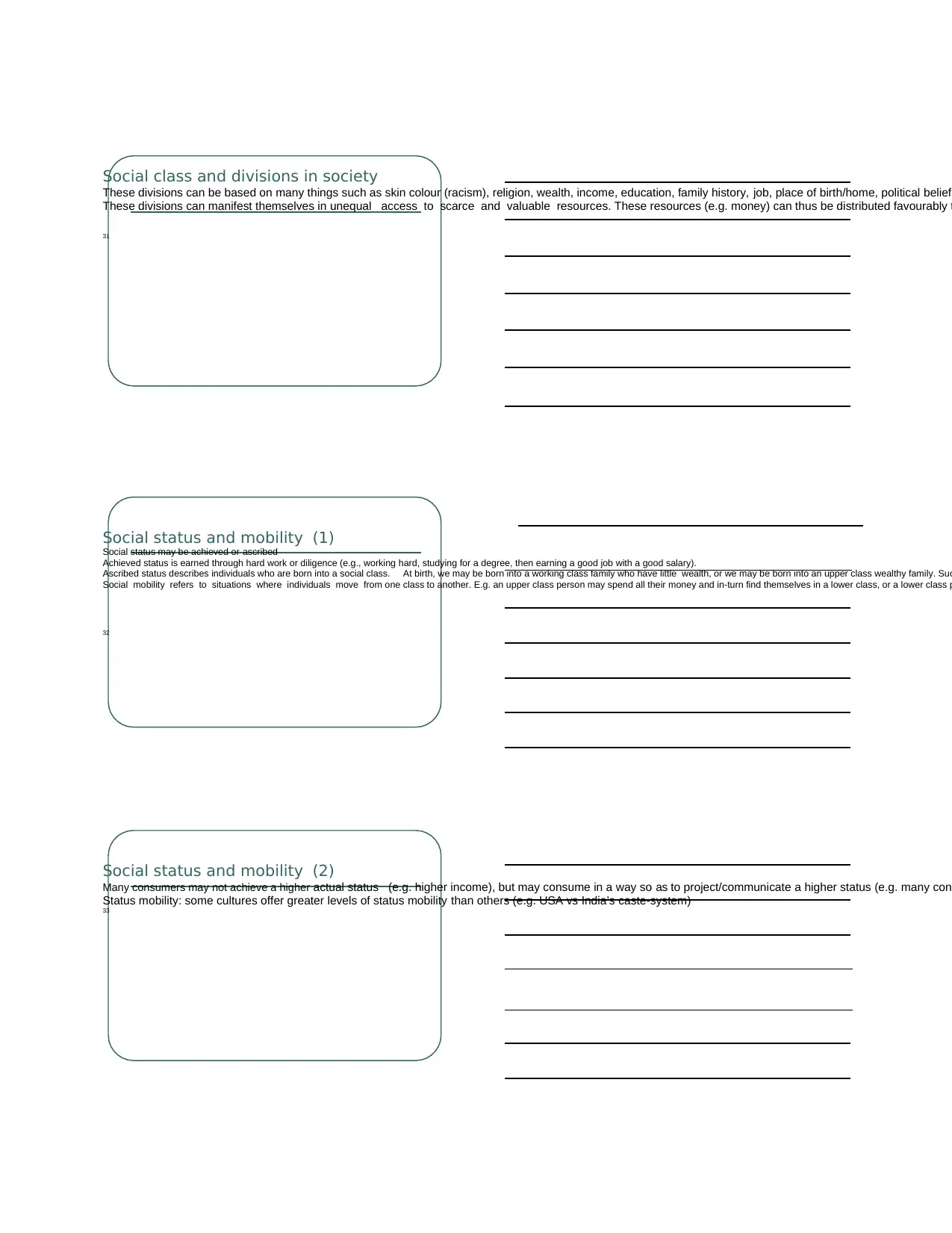
Social class and divisions in society
These divisions can be based on many things such as skin colour (racism), religion, wealth, income, education, family history, job, place of birth/home, political beliefs
These divisions can manifest themselves in unequal access to scarce and valuable resources. These resources (e.g. money) can thus be distributed favourably t
31
Social status and mobility (1)
Social status may be achieved or ascribed
Achieved status is earned through hard work or diligence (e.g., working hard, studying for a degree, then earning a good job with a good salary).
Ascribed status describes individuals who are born into a social class. At birth, we may be born into a working class family who have little wealth, or we may be born into an upper class wealthy family. Suc
Social mobility refers to situations where individuals move from one class to another. E.g. an upper class person may spend all their money and in-turn find themselves in a lower class, or a lower class p
32
Social status and mobility (2)
Many consumers may not achieve a higher actual status (e.g. higher income), but may consume in a way so as to project/communicate a higher status (e.g. many cons
Status mobility: some cultures offer greater levels of status mobility than others (e.g. USA vs India’s caste-system)
33
These divisions can be based on many things such as skin colour (racism), religion, wealth, income, education, family history, job, place of birth/home, political beliefs
These divisions can manifest themselves in unequal access to scarce and valuable resources. These resources (e.g. money) can thus be distributed favourably t
31
Social status and mobility (1)
Social status may be achieved or ascribed
Achieved status is earned through hard work or diligence (e.g., working hard, studying for a degree, then earning a good job with a good salary).
Ascribed status describes individuals who are born into a social class. At birth, we may be born into a working class family who have little wealth, or we may be born into an upper class wealthy family. Suc
Social mobility refers to situations where individuals move from one class to another. E.g. an upper class person may spend all their money and in-turn find themselves in a lower class, or a lower class p
32
Social status and mobility (2)
Many consumers may not achieve a higher actual status (e.g. higher income), but may consume in a way so as to project/communicate a higher status (e.g. many cons
Status mobility: some cultures offer greater levels of status mobility than others (e.g. USA vs India’s caste-system)
33
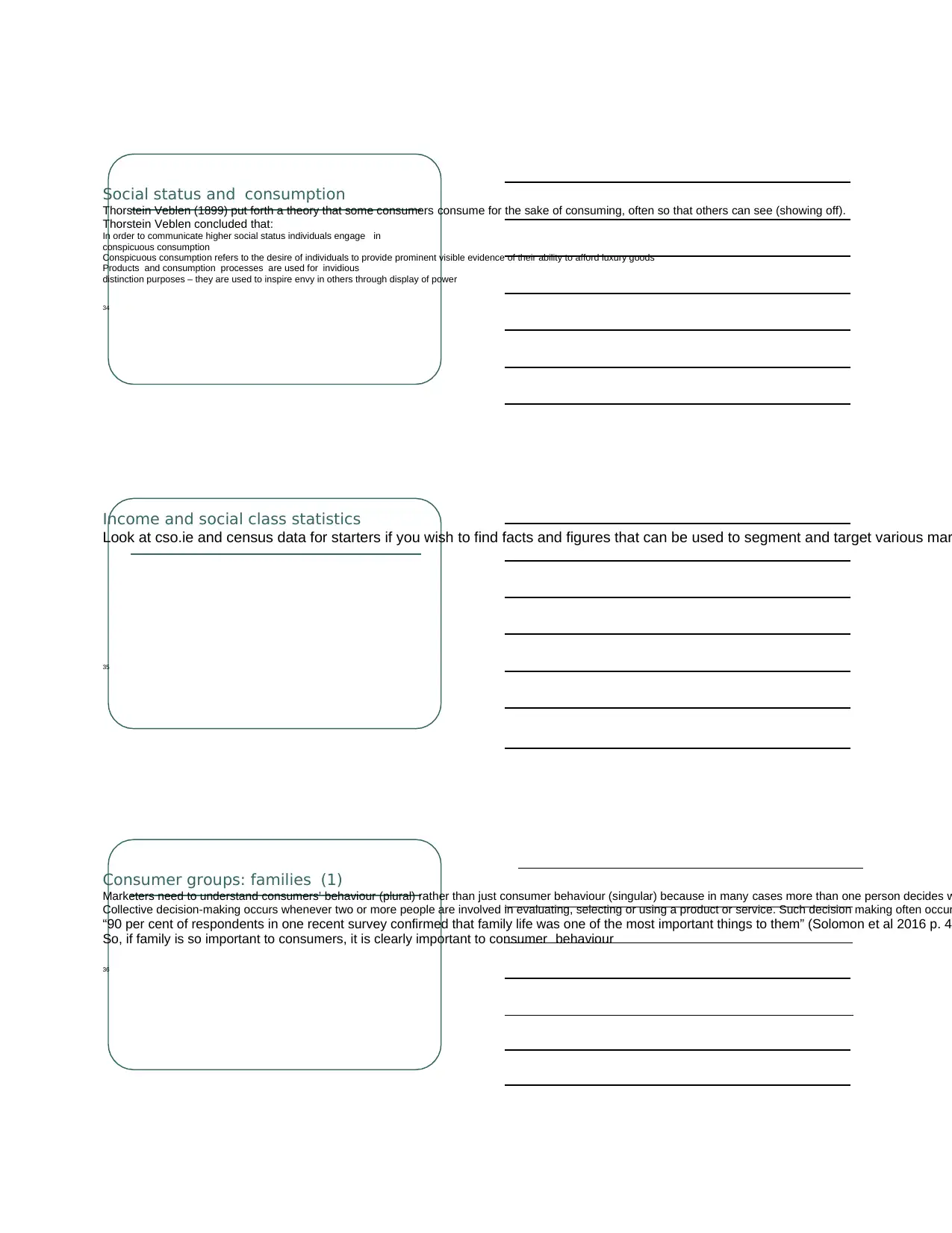
Social status and consumption
Thorstein Veblen (1899) put forth a theory that some consumers consume for the sake of consuming, often so that others can see (showing off).
Thorstein Veblen concluded that:
In order to communicate higher social status individuals engage in
conspicuous consumption
Conspicuous consumption refers to the desire of individuals to provide prominent visible evidence of their ability to afford luxury goods
Products and consumption processes are used for invidious
distinction purposes – they are used to inspire envy in others through display of power
34
Income and social class statistics
Look at cso.ie and census data for starters if you wish to find facts and figures that can be used to segment and target various mar
35
Consumer groups: families (1)
Marketers need to understand consumers’ behaviour (plural) rather than just consumer behaviour (singular) because in many cases more than one person decides w
Collective decision-making occurs whenever two or more people are involved in evaluating, selecting or using a product or service. Such decision making often occur
“90 per cent of respondents in one recent survey confirmed that family life was one of the most important things to them” (Solomon et al 2016 p. 43
So, if family is so important to consumers, it is clearly important to consumer behaviour
36
Thorstein Veblen (1899) put forth a theory that some consumers consume for the sake of consuming, often so that others can see (showing off).
Thorstein Veblen concluded that:
In order to communicate higher social status individuals engage in
conspicuous consumption
Conspicuous consumption refers to the desire of individuals to provide prominent visible evidence of their ability to afford luxury goods
Products and consumption processes are used for invidious
distinction purposes – they are used to inspire envy in others through display of power
34
Income and social class statistics
Look at cso.ie and census data for starters if you wish to find facts and figures that can be used to segment and target various mar
35
Consumer groups: families (1)
Marketers need to understand consumers’ behaviour (plural) rather than just consumer behaviour (singular) because in many cases more than one person decides w
Collective decision-making occurs whenever two or more people are involved in evaluating, selecting or using a product or service. Such decision making often occur
“90 per cent of respondents in one recent survey confirmed that family life was one of the most important things to them” (Solomon et al 2016 p. 43
So, if family is so important to consumers, it is clearly important to consumer behaviour
36
⊘ This is a preview!⊘
Do you want full access?
Subscribe today to unlock all pages.

Trusted by 1+ million students worldwide
1 out of 43
Your All-in-One AI-Powered Toolkit for Academic Success.
+13062052269
info@desklib.com
Available 24*7 on WhatsApp / Email
![[object Object]](/_next/static/media/star-bottom.7253800d.svg)
Unlock your academic potential
Copyright © 2020–2025 A2Z Services. All Rights Reserved. Developed and managed by ZUCOL.